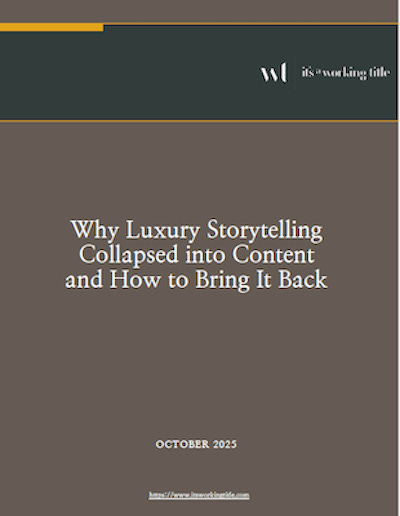Why Luxury Storytelling Collapsed into Content and How to Bring It Back
FSW explores why luxury storytelling is struggling and why strategic narrative systems are needed to restore coherence and cultural relevance.
Luxury is at a narrative crossroads. When it comes to commerce, consumers, and content, brands are so focused on visibility and “engagement” that they have lost the plot on what really matters: telling authentic narratives so compelling that consumers choose the brand, not the algorithm.
Our latest white paper, “Why Luxury Storytelling Collapsed into Content and How to Bring It Back,” is a luxury insider’s guide on how to build storytelling systems that create cultural gravity, design for intelligence, and transform content into a true strategic asset.
Developed by It’s A Working Title and powered by the thinking behind our FlexNarra flexible narrative design system, this paper reveals why luxury brand content is becoming a sea of sameness and what leaders can do to reverse the collapse. Luxury’s true advantage comes from shaping culture, not chasing it.
Some quick insights:
Luxury storytelling has fragmented due to the rise of e-commerce, social media, and short-term marketing tactics that prioritize visibility over value. This shift has led to disconnected brand narratives, diluted meaning, inflated tech stack spending, and declining consumer engagement, with Gen Z particularly sensitive to incoherent brand experiences.
Effective luxury storytelling requires a systematic approach through narrative architecture to connect all brand touchpoints into a cohesive ecosystem. This involves integrating creative storytelling with operational infrastructure to ensure continuity, flexibility, and emotional resonance across digital and IRL channels and markets.
Brands that win with quality content win with consumers. For brands to differentiate themselves and remain competitive, luxury storytelling should prioritize quality over quantity, focusing on building scalable, interconnected narrative systems. Brands like Miu Miu exemplify this approach by creating unified, culturally resonant stories, while others, like Louis Vuitton, risk losing coherence through excessive, unstructured content initiatives.
This paper examines the current landscape of luxury brand storytelling, tracing its evolution and fragmentation in response to the rapid shift to e-commerce during the pandemic and the growth of social media. It will explore why adopting a more systematic, structured approach to storytelling could offer a deeper, more authentic experience for both luxury brands and their customers.
The future of luxury storytelling demands both creative imagination and infrastructure. This is where the luxury narrative blueprint begins.
A smarter luxury storytelling system starts here. Define your narrative advantage.
Curious how content strategy and narrative architecture becomes practice? Explore our work at It’s A Working Title LLC.





So well observed🤍 Luxury lost its magic when it started performing rather than narrating. The strongest brands aren’t louder, they’re clearer.